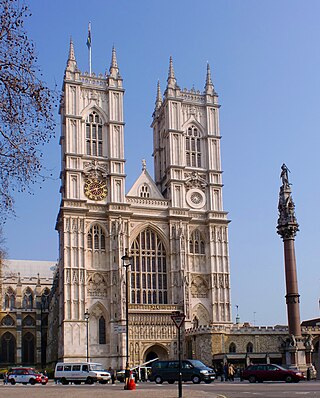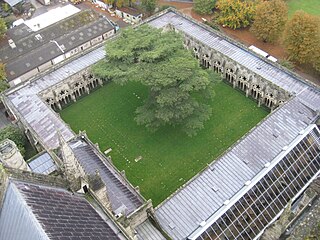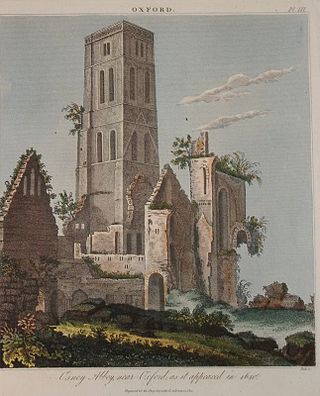
An abbey is a type of monastery used by members of a religious order under the governance of an abbot or abbess. Abbeys provide a complex of buildings and land for religious activities, work, and housing of Christian monks and nuns.

Westminster Abbey, formally titled the Collegiate Church of Saint Peter at Westminster, is an Anglican church in the City of Westminster, London, England. Since 1066, it has been the location of the coronations of 40 English and British monarchs and a burial site for 18 English, Scottish, and British monarchs. At least 16 royal weddings have taken place at the abbey since 1100.

Fountains Abbey is one of the largest and best preserved ruined Cistercian monasteries in England. It is located approximately 3 miles (5 km) south-west of Ripon in North Yorkshire, near to the village of Aldfield. Founded in 1132, the abbey operated for 407 years, becoming one of the wealthiest monasteries in England until its dissolution, by order of Henry VIII, in 1539.
The Priory Church of Saint Mary, Bushmead, commonly called Bushmead Priory, was a monastic foundation for Augustinian Canons, located at Bushmead in the County of Bedfordshire in England. It is a Grade I listed building.

Inchcolm Abbey is a medieval abbey located on the island of Inchcolm in the Firth of Forth in Scotland. The Abbey, which is located at the centre of the island, was founded in the 12th century during the episcopate of Gregoir, Bishop of Dunkeld. Later tradition placed it even earlier, in the reign of King Alexander I of Scotland (1107–24), who had taken shelter on Incholm when his ship was forced ashore during a storm in 1123. It is said he resided there for three days with the Hermit of Incholm.

A cloister is a covered walk, open gallery, or open arcade running along the walls of buildings and forming a quadrangle or garth. The attachment of a cloister to a cathedral or church, commonly against a warm southern flank, usually indicates that it is part of a monastic foundation, "forming a continuous and solid architectural barrier... that effectively separates the world of the monks from that of the serfs and workmen, whose lives and works went forward outside and around the cloister."

Long Crendon is a village and civil parish in west Buckinghamshire, England, about 3 miles (5 km) west of Haddenham and 2 miles (3 km) north-west of Thame in neighbouring Oxfordshire. The village has been called Long Crendon only since the English Civil War. The "Long" prefix refers to the length of the village at that time, and was added to differentiate it from nearby Grendon Underwood, which used to be known as "Crendon". This name is Old English and means 'Creoda's Hill'.

Nether Winchendon or Lower Winchendon is a village and civil parish in the Aylesbury Vale district of Buckinghamshire, England. It is near the county boundary with Oxfordshire, about 5.5 miles (9 km) west of Aylesbury and 2.5 miles (4 km) north of Haddenham.

Nether Winchendon House is a manor house in Nether Winchendon, in the Aylesbury Vale district of Buckinghamshire, England.

Osney Abbey or Oseney Abbey, later Osney Cathedral, was a house of Augustinian canons at Osney in Oxfordshire. The site is south of the modern Botley Road, down Mill Street by Osney Cemetery, next to the railway line just south of Oxford station. It was founded as a priory in 1129, becoming an abbey around 1154. It was dissolved in 1539 but was created a cathedral, the last abbot Robert King becoming the first Bishop of Oxford. The see was transferred to the new foundation of Christ Church in 1545 and the building fell into ruin. It was one of the four renowned monastic houses of medieval Oxford, along with St Frideswide's Priory, Rewley and Godstow.

Missenden Abbey is a former Arrouasian (Augustinian) monastery, founded in 1133 in Great Missenden, Buckinghamshire, United Kingdom. The abbey was dissolved in 1538, and the abbey church demolished. In 1574 a house, also known as Missenden Abbey, was constructed on the site of the monastic cloisters, incorporating some of the monastic remains. The house was altered several times, gaining its current "Regency Gothic" style at the beginning of the 19th century. The house was "gutted" by fire in 1985 and subsequently rebuilt.

The Abbey Lawn in Bourne, Lincolnshire, England, is a centrally located space used as the principal recreation ground in the town. The cricket, tennis, bowls, pétanque, and football clubs play their home fixtures here. The hockey club practices here, though it now plays its fixtures on an all-weather pitch elsewhere. "The Lawn" is the site of the Bourne Cricket Club (Lincolnshire) and its associated facilities.

Keynsham Abbey in Keynsham, Somerset, England, was a monastic abbey founded c. 1166 by William, Earl of Gloucester. The abbey was established as a house of Augustinian canons regular, and operated until the dissolution of the monasteries in 1539.

Ferns Abbey is a ruined Augustinian abbey in Ferns, County Wexford, Ireland. Likely built on the site of an early Christian monastic site founded by Máedóc of Ferns, the standing remains were built by Diarmait Mac Murchada c.1160. The abbey was suppressed on 7 April 1539.

The Abbey of Saint Mary de Pratis, more commonly known as Leicester Abbey, was an Augustinian religious house in the city of Leicester, in the East Midlands of England. The abbey was founded in the 12th century by the Robert de Beaumont, 2nd Earl of Leicester, and grew to become the wealthiest religious establishment within Leicestershire. Through patronage and donations the abbey gained the advowsons of countless churches throughout England, and acquired a considerable amount of land, and several manorial lordships. Leicester Abbey also maintained a cell at Cockerham Priory, in Lancashire. The Abbey's prosperity was boosted through the passage of special privileges by both the English Kings and the Pope. These included an exemption from sending representatives to parliament and from paying tithe on certain land and livestock. Despite its privileges and sizeable landed estates, from the late 14th century the abbey began to suffer financially and was forced to lease out its estates. The worsening financial situation was exacerbated throughout the 15th century and early 16th century by a series of incompetent, corrupt and extravagant abbots. By 1535 the abbey's considerable income was exceeded by even more considerable debts.

Botleys Mansion is a Palladian mansion house in the south of Chertsey, Surrey, England, just south of St Peter's Hospital. The house was built in the 1760s by builders funded by Joseph Mawbey and to designs by Kenton Couse. The elevated site once bore a 14th-century manor house seized along with all the other manors of Chertsey from Chertsey Abbey, a very rich abbey, under Henry VIII's Dissolution of the Monasteries and today much of its land is owned by two hospitals, one public, one private and the local council authority. The remaining mansion and the near park surrounding were used for some decades as a colony hospital and as a private care home. The building is owned and used by a wedding venues company.
Cain Manor is an Elizabethan building built in the late 16th century on what was then known as Headley Common, in the parish of Headley, Hampshire England; it sits on broad slopes at the foot of the South Downs National Park centred about 2 miles (3.2 km) away from the village of Churt in Surrey. Its name Manor should be described as Manor House, if its implied manor house status can be proven.

St Gertrude's Abbey is a complex of former monastic buildings in Leuven, Belgium. An Augustinian priory founded in 1206 was suppressed in 1797. After restoration, the monastic buildings were used between 1917 and 1968 by Benedictine nuns as a house of studies and student residence.

The Priory of Saint Mary, Clontuskert-Hy-Many, also called Clontuskert Abbey, is a medieval Augustinian priory and National Monument located in County Galway, Ireland.

















